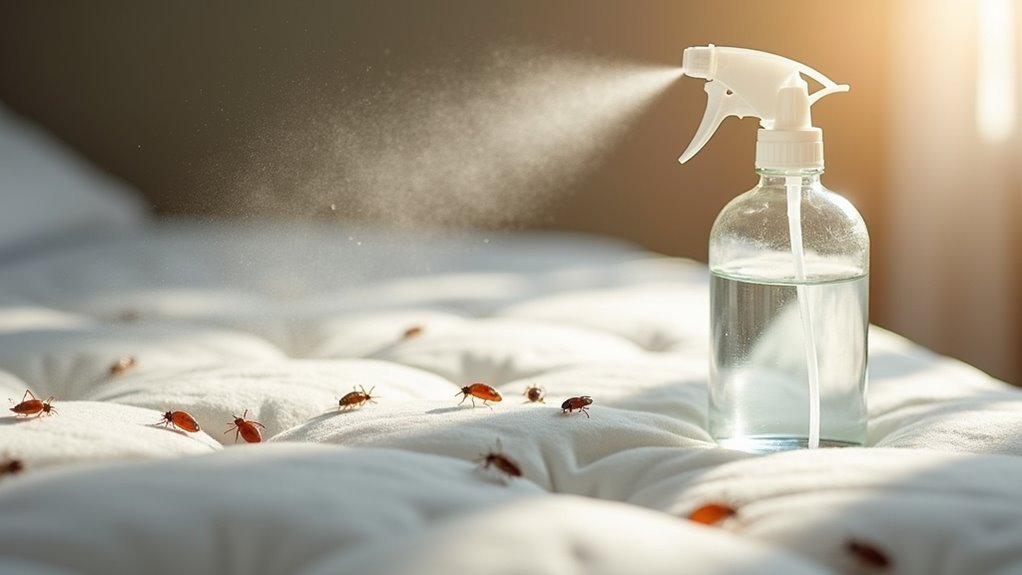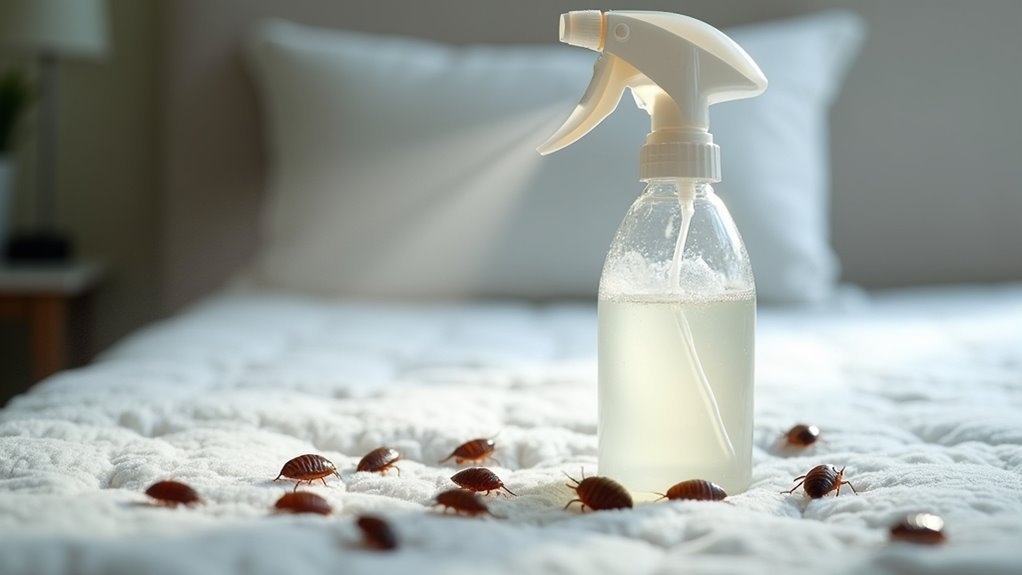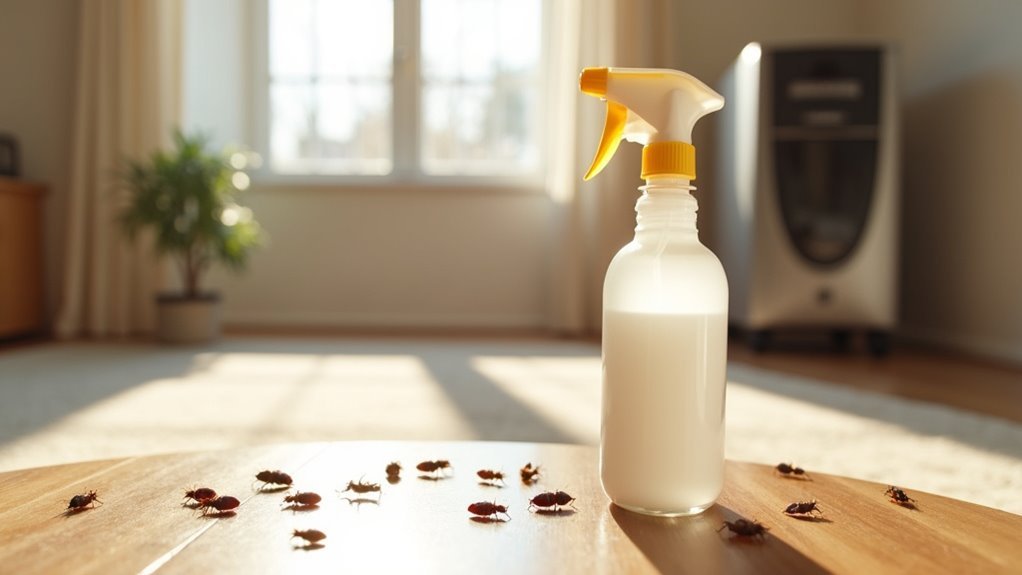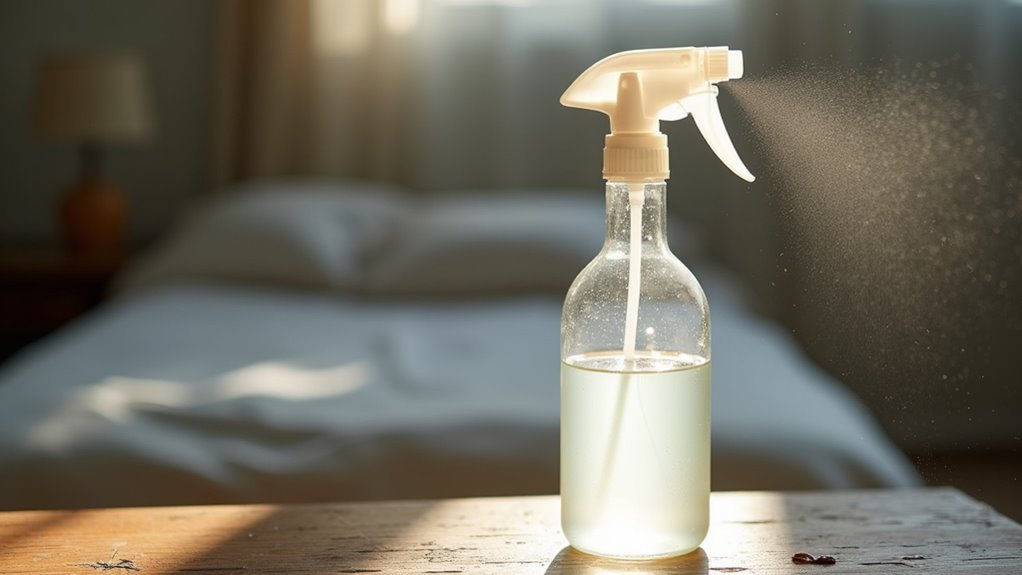You can kill bed bugs instantly by spraying them directly with 3% hydrogen peroxide, which disrupts their cellular functions through oxidative damage that destroys essential proteins and enzymes. While it’s more effective than rubbing alcohol’s 50% kill rate, you’ll need protective eyewear to prevent eye injuries and must apply it directly to visible bugs and hiding spots like mattress seams. However, hydrogen peroxide has limitations for widespread infestations and can permanently bleach fabrics, so you’ll want to explore extensive treatment strategies.
How Hydrogen Peroxide Works Against Bed Bugs

Three key mechanisms make hydrogen peroxide an effective contact killer against bed bugs.
First, its oxidative properties disrupt the cellular functions of bed bugs, causing immediate death upon contact. You’ll find that hydrogen peroxide acts as a powerful disinfectant that breaks down the bugs’ biological systems at the molecular level.
Second, the chemical penetrates the bed bug’s exoskeleton, delivering fatal damage to internal organs and tissues. This rapid action makes it an appealing treatment option for homeowners seeking quick results.
Third, hydrogen peroxide’s reactive nature destroys proteins and enzymes essential for the bugs’ survival.
However, you must apply it directly to kill bed bugs effectively, which limits its usefulness for widespread infestation control in hard-to-reach areas.
Safety Risks and Fabric Damage Concerns
While hydrogen peroxide may kill bed bugs on contact, its use comes with significant safety risks that you can’t ignore. The chemical can cause burns on your skin and respiratory irritation, making proper safety precautions absolutely essential.
Even household-strength 3% hydrogen peroxide poses health risks if you don’t wear protective eyewear during application.
Even low-concentration hydrogen peroxide can cause serious eye injuries without proper protective equipment during bed bug treatment.
Essential safety measures include:
- Wearing protective gloves and eyewear to prevent chemical burns
- Ensuring proper ventilation to avoid inhaling toxic fumes
- Keeping hydrogen peroxide away from children and pets
- Testing fabric areas before widespread application
- Having emergency contact information readily available
Beyond health risks, you’ll face significant fabric damage concerns. Hydrogen peroxide’s bleaching properties can permanently discolor your bedding, mattresses, and clothing, creating costly replacement expenses that often exceed professional pest control services.
Direct Application Methods for Maximum Effectiveness

Although hydrogen peroxide’s bleaching risks are concerning, you can achieve maximum effectiveness by applying the 3% solution directly onto visible bed bugs and their primary hiding locations.
Focus your direct application on mattress seams, bed frame joints, and furniture cracks where bugs typically hide. You’ll need to spray thoroughly, ensuring the hydrogen peroxide contacts the bugs immediately for lethal results.
Keep treated areas wet for several minutes, allowing the solution to penetrate their exoskeletons completely. This method will kill bed bugs on contact when applied properly.
However, remember that direct application alone won’t eliminate an entire infestation. You’ll need to combine hydrogen peroxide treatment with other extensive pest control methods for complete eradication success.
Comparing Hydrogen Peroxide to Other DIY Solutions
When evaluating DIY bed bug treatments, hydrogen peroxide stands out for its instant kill rate upon direct contact, outperforming rubbing alcohol’s maximum 50% effectiveness.
However, you’ll need to weigh several factors when choosing your bed bug treatment approach.
Here’s how hydrogen peroxide compares to other DIY solutions:
- Diatomaceous earth dehydrates bugs effectively but works slower than hydrogen peroxide’s instant action.
- Rubbing alcohol kills only 50% of bed bugs versus hydrogen peroxide’s complete kill on contact.
- Vinegar damages nervous systems but doesn’t guarantee eradication like hydrogen peroxide does.
- Essential oils merely repel bugs without killing them, unlike hydrogen peroxide’s lethal effect.
- Heat treatment eliminates all life stages instantly, making it more thorough than hydrogen peroxide.
While hydrogen peroxide can kill bed bugs instantly, it may damage fabrics and poses health risks during application.
Professional Heat Treatment vs. Chemical Sprays

Heat treatment eliminates 100% of bed bugs and their eggs by raising room temperatures to lethal levels, while chemical sprays like hydrogen peroxide require direct contact and multiple applications to achieve similar results. Professional exterminators use advanced equipment to heat infested areas to at least 130°F, killing all life stages instantly.
| Heat Treatment | Chemical Sprays |
|---|---|
| Kills bugs instantly at 130°F | May take multiple applications |
| Penetrates furniture and bedding | Can miss hidden bugs in cracks |
| Non-toxic, no residues | Potential health risks if misapplied |
| Advanced professional equipment | Basic spray application |
Unlike chemical sprays that rely on neurotoxic agents, heat treatment provides immediate results for severe infestations. This thorough pest control approach guarantees you’ll eliminate bed bugs without fabric damage or toxic residues.
Identifying Bed Bug Hiding Spots Before Treatment
Where exactly do bed bugs lurk when they’re not feeding on you at night? You’ll find them squeezed into mattress seams, box spring crevices, and bedding folds where they feel secure.
To identify bed bugs effectively, examine furniture joints, bed frame cracks, and areas behind headboards where these pests commonly establish themselves.
Thorough inspection of furniture joints, bed frame cracks, and headboard areas reveals where bed bugs typically establish their hiding spots.
Key locations where bed bugs hide include:
- Mattress seams and box spring crevices
- Bed frame joints and headboard gaps
- Furniture cracks and upholstery folds
- Cluttered areas near sleeping spaces
- Luggage and clothing after travel
Look for dark fecal spots and shed skins in these cracks and crevices—telltale signs of a bed bug infestation.
Reduce clutter around beds to expose hiding spots and make your inspection more thorough before applying hydrogen peroxide treatment.
Proper Ventilation and Protective Equipment Requirements
Before spraying hydrogen peroxide to eliminate bed bugs, you’ll need to prioritize safety by establishing proper ventilation and wearing protective equipment. Open windows and position fans throughout the treatment area to prevent harmful fumes from accumulating.
Don’t skip protective equipment—wear gloves and goggles to shield your skin and eyes from irritation. For respiratory protection, use a mask to avoid inhaling dangerous vapors during application.
Clear the area of pets and children before treatment begins. They shouldn’t return until surfaces are completely dry.
After you’ve finished spraying, maintain ventilation for at least thirty minutes before re-entering the space. This waiting period guarantees safe air quality and prevents accidental exposure to residual fumes that could cause health complications.
Limitations of Hydrogen Peroxide for Large Infestations
While hydrogen peroxide kills bed bugs on contact, it won’t solve large infestations effectively.
Contact kills don’t eliminate hidden bed bugs in wall cracks and furniture crevices where colonies continue reproducing.
You’ll face significant challenges when dealing with widespread bed bug problems using this method alone.
The main limitations you’ll encounter include:
- Limited penetration – hydrogen peroxide can’t reach bugs hiding in mattress seams, wall cracks, or furniture crevices.
- Time-intensive application – treating every affected area requires multiple rounds of spraying.
- Material damage risk – bleaching properties can ruin your bedding, clothing, and upholstery.
- Incomplete eradication – hidden bugs will continue reproducing after treatment.
- Cost inefficiency – purchasing enough hydrogen peroxide becomes expensive for large areas.
For large infestations, you’re better off investing in professional pest control services that use heat treatments or specialized insecticides for complete elimination.
Alternative Instant-Kill Methods for Bed Bugs
While hydrogen peroxide has limitations for large infestations, you’ve got several other instant-kill methods at your disposal.
Heat treatment methods like steam can eliminate both bed bugs and their eggs on contact without any chemical risks.
You can also turn to chemical contact killers such as rubbing alcohol and disinfectants, or explore cold application techniques that freeze these pests instantly.
Heat Treatment Methods
When you’re dealing with a severe bed bug infestation, heat treatment offers one of the most thorough instant-kill methods available.
You’ll need to raise temperatures between 130°F and 145°F to kill the bed bug at all life stages, including eggs, within minutes. This approach penetrates deep into walls, furniture, and bedding where bugs hide.
Key advantages of heat treatment for bug extermination:
- No chemical residues – Safe for humans and pets when conducted properly
- Comprehensive coverage – Reaches hidden bugs in inaccessible areas
- Quick results – Eliminates all life stages within minutes
- Professional equipment – Guarantees uniform heat distribution
- Effective penetration – Works through various surfaces and materials
Before treatment, you’ll need to remove flammable items and guarantee proper heat circulation to solve your bed bug problem effectively.
Chemical Contact Killers
If heat treatment isn’t feasible for your situation, chemical contact killers provide another instant-kill option for bed bugs you can see and reach directly.
Hydrogen peroxide works effectively upon direct contact, though it won’t eliminate entire infestations. You’ll find rubbing alcohol kills up to 50% of bed bugs it touches, but it’s useless against eggs and nymphs.
Disinfectants with isopropyl alcohol or ethanol deliver instant kills but pose inhalation risks. Bleach can kill bed bugs in washing or spray applications, though it damages materials and creates health hazards.
For safer alternatives, consider diatomaceous earth or silica gel – these household item options dehydrate bed bugs on contact without liquid chemical risks.
Cold Application Techniques
Though chemical contact killers offer immediate results, cold application techniques present another instant-kill method that freezes bed bugs at temperatures below their survival threshold.
You can kill a bed bug instantly using liquid nitrogen at -32°F, but this approach requires specialized equipment that’s less accessible than using heat methods.
Cold application techniques work best when you catch an infestation early and can target visible bugs directly. The extreme temperature must penetrate thoroughly to reach all bugs and eggs for complete elimination.
Consider these advantages of cold treatments:
- Safer alternative – No toxic chemical exposure for your family or pets
- Instant results – Freezes bugs immediately upon contact
- Chemical-free – Eliminates pesticide residue concerns
- Targeted application – Precise control over treatment areas
- Environmentally friendly – No harmful chemical runoff
However, cold methods struggle with hidden infestations since they can’t penetrate deep into furniture or walls effectively.
When to Call Professional Exterminators Instead
You’ll know it’s time to call professionals when you’re spotting bed bugs in multiple rooms, finding them during daylight hours, or noticing a strong musty odor throughout your home.
These severe infestation signs indicate the problem has grown beyond what hydrogen peroxide and other DIY methods can handle effectively.
Professional exterminators bring specialized equipment like heat treatment systems and commercial-grade insecticides that target all bed bug life stages, giving you the thorough elimination you can’t achieve on your own.
Severe Infestation Signs
While hydrogen peroxide can tackle minor bed bug problems, certain warning signs indicate you’re dealing with an infestation that’s beyond DIY solutions.
When severe infestation signs become apparent, killing bed bugs requires professional intervention rather than home remedies.
You should contact exterminators immediately if you notice these critical warning signs:
- Multiple live bugs crawling across surfaces, especially during daylight hours
- Numerous shed skins and dark stains covering sheets and mattresses
- Clusters of itchy, red bite marks appearing regularly on your skin
- Strong, musty odors permeating your bedroom and surrounding areas
- Bed bugs spreading beyond the bedroom into living rooms and other spaces
When you find bed bugs exhibiting these severe patterns, hydrogen peroxide won’t provide the thorough eradication needed to eliminate the entire population effectively.
Professional Treatment Benefits
When severe infestations overwhelm your DIY efforts, professional exterminators bring specialized expertise and equipment that hydrogen peroxide simply can’t match.
You’ll benefit from advanced treatment methods like whole-room heat treatments that achieve effective elimination of bed bugs at all life stages in one session. Exterminators conduct detailed inspection of your property, identifying hidden harborages that you might miss.
Their targeted treatment reaches difficult areas where bed bugs commonly hide, using potent insecticides unavailable to consumers.
While professional services cost $1,000-$2,500, you’re investing in long-term peace of mind. You’ll receive follow-up monitoring and services ensuring complete resolution.
When hydrogen peroxide and other DIY methods fail against severe infestations, professionals offer the thoroughness and effectiveness needed for permanent eradication.
Frequently Asked Questions
Can Hydrogen Peroxide Get Rid of Bed Bugs?
You can kill bed bugs on contact with hydrogen peroxide, but it won’t eliminate eggs or nymphs effectively. It’s not practical for widespread infestations and may damage fabrics while posing health risks.
Can I Spray My Bed With Hydrogen Peroxide?
You can spray your bed with hydrogen peroxide, but it’ll likely damage your mattress and bedding due to bleaching effects. It won’t eliminate hidden bugs or eggs effectively either.
What Household Product Kills Bed Bugs Instantly?
You can use rubbing alcohol, hydrogen peroxide, or bleach to kill bed bugs instantly on contact. However, these household products won’t eliminate hidden eggs and nymphs throughout your home effectively.
Do Baking Soda and Peroxide Kill Bed Bugs?
You can kill some bed bugs with baking soda and peroxide, but it’s not reliable for entire infestations. The combination isn’t scientifically proven effective, so you’ll need professional treatment for complete elimination.
In Summary
You’ll find hydrogen peroxide spray can kill bed bugs on contact, but it’s not a complete solution for serious infestations. You’re risking fabric damage and safety concerns with direct application, so you’ll need proper ventilation and protective gear. While it’s faster than some DIY methods, you shouldn’t rely on it for large-scale problems. If you’re dealing with widespread infestations, you’ll get better results calling professional exterminators instead.





Leave a Reply